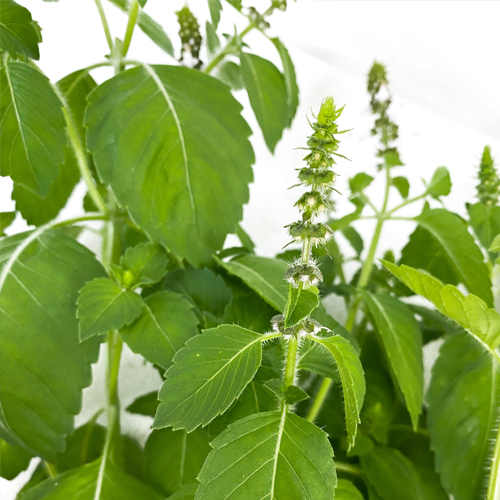Holy Basil
Latin name: Ocimum tenuiflorum
🌱 Days to Sprout: 5-14
😋 Ready for Full Dose of plant food with true leaves or roots .5-inch long
✂️ Thin to: 3 plants per yCube
🍅 Days to Maturity: 70
💡 Light Zone: High
📏 Plant Size: <2 ft
💚 Care Level: Beginner
Origin
Holy Basil, also known as Tulsi or Sacred Basil, has been used since ancient times and is native to India. Some call Holy Basil “Queen of the Herbs” as it has been used by Hindu monks and Ayurvedic practitioners for centuries. Considered sacred to the Hindu god Vishnu, Holy Basil is used in morning prayers to ensure good health, spiritualism, and the well-being of one’s family.
Qualities
Holy Basil's oval leaves and pink blossoms are very aromatic and have a mild anise or licorice flavor with some peppery and minty undertones. Holy Basil is high in antioxidants, and its essential oils contain eugenol, which has anti-inflammatory properties.
Use
While Holy Basil is most commonly used to make herbal teas, it is also very popular in many Thai dishes such as the famous Thai basil chicken, known as pad krapow gai.
Care & Harvest
💡Temperature: Prefers warmer temperatures (70-75°F).
✂️ Pruning: Remove leaves with brown or yellow spots if they appear. Check the roots monthly and trim any that are brown or extending past the yPod. For bushier growth, regularly harvest at the stem above the growth nodes (see Harvest below). Flowers can be pruned to promote bushiness and delay bolting - they're edible!
🔎 Plant Health: Root rot and Downy Mildew are common diseases best controlled by regular root checks and removing any leaves with brown spots if they appear.
🌿 Harvest: Harvesting frequently helps prolong the plant's life. Pinch off individual leaves, or use clean shears to cut stems above growth nodes. Find growth nodes just above the two largest leaves on a stem. You should see another, small set of leaves or knobs (nodes) growing between the stem and larger set of leaves. Cut the stem 1/4-1/2″ above the nodes and watch the small leaves grow large! Stems, leaves, flowers, and seeds are all edible.
Our Plant Health & Nutrition Team thoroughly tests each variety we offer to bring you the most flavorful and high-quality plants. We regularly rotate our plant portfolio, so please note, availability varies.

